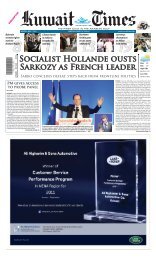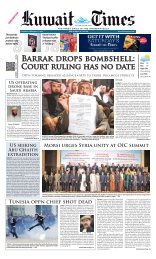NEw SARS-likE viRUS EMERGES iN MidEASt - Kuwait Times
NEw SARS-likE viRUS EMERGES iN MidEASt - Kuwait Times
NEw SARS-likE viRUS EMERGES iN MidEASt - Kuwait Times
You also want an ePaper? Increase the reach of your titles
YUMPU automatically turns print PDFs into web optimized ePapers that Google loves.
HO CHI MINH CITY: Policemen and security staff secure the main entrance<br />
gate of Ho Chi Minh City’s People’s Court where three bloggers stand trial<br />
for “anti-state propaganda” yesterday. The court in southern Vietnam jailed<br />
three bloggers for “anti-state propaganda”, including one whose case has<br />
been raised by US President Barack Obama. —AFP<br />
New Zealand agents spied<br />
‘unlawfully’ in Dotcom case<br />
WELLINGTON: New Zealand Prime<br />
Minister John Key has ordered an inquiry<br />
into government agents spying “unlawfully”<br />
while assisting police in the lead up to<br />
the arrest of Megaupload boss Kim<br />
Dotcom.<br />
Key said yesterday he has told the<br />
Intelligence and Security department to<br />
investigate “the circumstances of unlawful<br />
interception of communications of certain<br />
individuals by the Government<br />
Communications Security Bureau”.<br />
He said a memorandum had also been<br />
filed in the High Court dealing with the<br />
Megaupload case advising that the bureau<br />
“had acted unlawfully while assisting the<br />
police” to locate people subject to arrest<br />
warrants issued in the case.<br />
Key did not name Dotcom specifically,<br />
but said the bureau “had acquired communications<br />
in some instances without statutory<br />
authority”.<br />
Dotcom is fighting extradition to the<br />
United States after being arrested in<br />
January by New Zealand police cooperating<br />
with a major US investigation.<br />
The US Justice Department and FBI<br />
claim Megaupload and related sites netted<br />
more than $175 million in criminal proceeds<br />
and cost copyright owners over $500<br />
million by offering pirated copies of<br />
movies, TV shows and other content.<br />
The 38-year-old German national, who<br />
legally changed his name from Kim<br />
Schmitz, had moved to New Zealand in early<br />
2010 and enjoyed a lavish lifestyle until<br />
his arrest.<br />
Key said he was “quite shocked” to learn<br />
the government secret agents had acted<br />
unlawfully.<br />
“I expect our intelligence agencies to<br />
operate always within the law. Their operations<br />
depend on public trust,” he said.<br />
Key said he had not been asked to sign<br />
an intercept warrant in relation to<br />
the case “nor was I briefed on the operation<br />
in question” but he added he believed<br />
the incident was an isolated error.<br />
“Because this is also a matter for the<br />
High Court in its consideration of the<br />
Megaupload litigation, I am unable to comment<br />
further.” —AFP<br />
Kaspersky releases new<br />
consumer products<br />
DUBAI: Kaspersky Lab announces the release<br />
of its new flagship consumer products:<br />
Kaspersky Internet Security 2013Premium<br />
Security Suite;and Kaspersky Anti-Virus<br />
2013Essential Protection Solution.The new<br />
versions of both products share the refined,<br />
easy-to-use interface and deliver new technologies<br />
to provide maximum protection<br />
against all kinds of threats. In response to the<br />
ever-changing threat landscape, particular<br />
attention has been paid to the security of<br />
potentially vulnerable applications thanks to<br />
the unique Automatic Exploit Prevention technology.<br />
Users of the brand new version of<br />
Kaspersky Internet Security will also enjoy<br />
complete protection for their online purchases<br />
and online banking transactions, thanks to the<br />
easy-to-use Safe Moneyfeature. Both products<br />
are fully compatible with the Windows 8 operating<br />
system, efficiently protecting applications<br />
and user data, whether in the classic<br />
orthe new touch-friendly user interfaces.<br />
Eugene Kaspersky, CEO and co-founder of<br />
Kaspersky Lab, commented: “When developing<br />
the new versions of our home user products<br />
we paid particular attention to the users’<br />
needs as well as the threats they face.<br />
Knowing that the loss of sensitive data and<br />
money are the things that worry users most,<br />
we have developed an entire set of new protection<br />
technologies to address these concerns.<br />
Kaspersky Internet Security 2013 is now<br />
better than ever when it comes to protecting<br />
the most valuable information during online<br />
activities. With its Hybrid Protection approach<br />
and new Automatic Exploit Prevention and<br />
Safe Money technologies,Kaspersky Internet<br />
Security 2013 helps our customers build the<br />
most efficient security system that is also easy<br />
to set up and use.”<br />
Main highlights<br />
● New antivirus engine with better detection<br />
rates for the entire scope of emerging<br />
cyber threats<br />
● Unique Automatic Exploit Prevention<br />
technology targets the most sophisticated<br />
threats utilizing vulnerabilities in popular software<br />
● Simplified user interface provides easier<br />
installation, activation and day-to-day use of<br />
the product<br />
● Better performance in key user scenarios<br />
and longer battery life for mobile computers<br />
New Kaspersky Internet Security features<br />
● Unique Safe Money technology protects<br />
users’ money “at all costs” during online shopping<br />
and banking<br />
● New anti-spam module efficiently blocks<br />
unwanted mail, saving you time and hassle<br />
Learn more about the key benefits of Kaspersky<br />
Internet Security 2013 in this infographic.<br />
Technology behind the<br />
world-class security suite<br />
Kaspersky Internet Security 2013 offers a<br />
number of brand new technologies, designed<br />
to combat the most widespread and sophisticated<br />
threats that target your personal data<br />
and bank accounts. Key among them are the<br />
unique Automatic Exploit Prevention and Safe<br />
Money technologies.<br />
Protection from zero-day exploits<br />
Automatic Exploit Prevention technology<br />
was designed to address some of the most<br />
sophisticated threats - those exploiting vulnerabilities<br />
in popular software. Exploits<br />
have long become the cybercriminals’<br />
weapon of choice forperforming online<br />
attacks known as ‘drive-by downloads’ -<br />
when a user gets infected just by visiting a<br />
certain webpage.<br />
Automatic Exploit Prevention protects<br />
Kaspersky Lab’s customers against these<br />
types of exploits, including those that utilize<br />
so-called zero-day vulnerabilities. The latter<br />
are among the most dangerous, infecting<br />
the system using unknown or unpatched<br />
security flaws in popular software.Based on<br />
Kaspersky Lab’s vast experience in IT security,<br />
the Automatic Exploit Prevention technology<br />
is able to recognize unauthorized<br />
activity by an exploit without blocking the<br />
normal operation of a potentially vulnerable<br />
program such as your web browser, document<br />
viewer etc. Learn more in this white<br />
paper.<br />
Secure online shopping and banking<br />
Safe Money technology contains a<br />
diverse set of protection methods for when<br />
you deal with real money online. Such activity<br />
may include making purchases online,<br />
working with an electronic payment system<br />
like PayPal, or accessing your bank account<br />
from your computer. Available in Kaspersky<br />
Internet Security 2013, this new feature provides<br />
enhanced protection for your banking<br />
operations.Here is how it works:<br />
● Switches automatically to special “Safe<br />
Browser” mode when you visit banking websites;<br />
thisisolates your payment operation<br />
from other online activities to ensure your<br />
transaction is not monitored<br />
● Activates automatically when visiting<br />
most common payment websites, and you<br />
can easily add your own bank or shopping<br />
website to the list<br />
● Checks the authenticity of the payment<br />
website itself to ensure the site isn’t compromised<br />
or a fake<br />
● Safe Money evaluates the security status<br />
of your computer, and warns about significant<br />
threats that should be addressed<br />
prior to making payments<br />
● Virtual Keyboard ensures tamper-proof<br />
entry of your password or credit card number<br />
New and improved security features<br />
Both Kaspersky Internet Security 2013<br />
and Kaspersky Anti-Virus 2013 solutions<br />
share the new antivirus engine, which offers<br />
better detection of all types of malicious<br />
programs, including the most complex samples.<br />
Particularly, specific methods have<br />
been introduced to better fight complex<br />
and targeted threatsby neutralizing<br />
attempts to embed malicious code into core<br />
system processes. At the same time, our new<br />
consumer products provide smaller and<br />
faster database updates thanks to certain<br />
parts of the antivirus databases being transferred<br />
to the cloud-based Kaspersky<br />
Security Network.<br />
27<br />
TECHNOLOGY<br />
TUESDAY, SEPTEMBER 25, 2012<br />
Data that lives forever<br />
is possible: Hitachi<br />
New method of storing digital information<br />
TOKYO: As Bob Dylan and the Rolling<br />
Stones prove, good music lasts a long time;<br />
now Japanese hi-tech giant Hitachi says it<br />
can last even longer-a few hundred million<br />
years at least. The company yesterday<br />
unveiled a method of storing digital information<br />
on slivers of quartz glass that can<br />
endure extreme temperatures and hostile<br />
conditions without degrading, almost forever.<br />
And for anyone who updated their LP<br />
collection onto CD, only to find they then<br />
needed to get it all on MP3, a technology<br />
that never needs to change might sound<br />
appealing.<br />
“The volume of data being created every<br />
day is exploding, but in terms of keeping it<br />
for later generations, we haven’t necessarily<br />
improved since the days we inscribed<br />
things on stones,” Hitachi researcher<br />
Kazuyoshi Torii said. “The possibility of losing<br />
information may actually have<br />
increased,” he said, noting the life of digital<br />
media currently available-CDs and hard<br />
drives-is limited to a few decades or a century<br />
at most.<br />
And the rapid development of technologies<br />
has resulted in frequent changes of<br />
data-reading hardware.<br />
“As you must have experienced, there is<br />
the problem that you cannot retrieve information<br />
and data you managed to collect,”<br />
said Torii, apparently referring to now-obsolete<br />
record players and cine films.<br />
Hitachi’s new technology stores data in<br />
binary form by creating dots inside a thin<br />
sheet of quartz glass, which can be read<br />
with an ordinary optical microscope.<br />
Provided a computer with the know-how<br />
to understand that binary is available-simple<br />
enough to programme, no matter how<br />
advanced computers become-the data will<br />
always be readable, Torii said.<br />
The prototype storage device is two centimetres<br />
(0.8 inches) square and just two<br />
millimetres (0.08 inches) thick and made<br />
from quartz glass, a highly stable and<br />
SAN FRANCISCO: As the mobile computing<br />
wars heat up, chipmakers that supply the<br />
crucial components inside smartphones and<br />
tablets aim to grab more of the glory.<br />
Not content to remain in the shadows of<br />
hot consumer brands like Apple or Samsung,<br />
chipmakers — including Intel, Qualcomm<br />
and Nvidia — want consumers to get to<br />
know the processors that power their mobile<br />
devices. They hope to build brand loyalty in<br />
the process.<br />
Intel is leading the charge by extending<br />
its hugely successful “Intel Inside” marketing<br />
campaign beyond personal computers.<br />
Launched in 1991, “Intel Inside” stickers<br />
turned commodity electronic components<br />
into premium products, and eventually<br />
became ubiquitous on laptops.<br />
This year, the Intel Inside logo has<br />
appeared on the backs of smartphones<br />
launched in the United Kingdom, India and<br />
Russia.<br />
Intel hopes to bring the phone campaign<br />
to the United States next year, seeking a marketing<br />
advantage over rivals like Qualcomm<br />
and Nvidia, which are not as well-known<br />
among consumers.<br />
“Without a doubt, my goal would be to<br />
have consumers walk into stores and have<br />
Intel Inside as a key driver of which phone or<br />
tablet they choose, just like we’ve done in<br />
the PC space,” said Brian Fravel, Intel’s head<br />
of branding.<br />
The world’s top chipmaker dominates the<br />
PC market but lags smaller competitors in<br />
the fast-growing mobile industry. Intel is<br />
flexing its branding muscle to try to catch<br />
up.<br />
It remains to be seen how many handset<br />
manufacturers agree to put the Intel Inside<br />
logo on their devices. For emerging smartphone<br />
brands, with little name recognition<br />
of their own, partnering with Intel may be a<br />
“no brainer.” At the other extreme, Apple<br />
refuses to share branding with any of its suppliers.<br />
The highest-profile smartphone maker so<br />
far to use Intel’s branding is Google’s<br />
Motorola Mobility, which launched the Razr i<br />
in London on Sept 18.<br />
Until now, space on most smartphones<br />
has been reserved for the vendor, such as<br />
Apple or Samsung, and carriers like Verizon<br />
Wireless.<br />
Providers of operating systems , such as<br />
Google’s Android, also covet consumer loyalty<br />
- their logos sometimes appear briefly on<br />
screens when devices are turned on.<br />
A logo-happy approach to smartphones<br />
and tablets, though, would run the risk of<br />
confusing consumers with what some<br />
experts call the NASCAR effect.<br />
As a rule, it’s seen as a good idea to add<br />
extra branding to products only when the<br />
additional brand strongly conveys a quality<br />
that the handset maker’s own brand lacks.<br />
resilient material, used to make beakers and<br />
other instruments for laboratory use.<br />
The chip, which is resistant to many chemicals<br />
and unaffected by radio waves, can be<br />
exposed directly to high temperature flames<br />
and heated to 1,000 degrees Celsius (1,832<br />
Fahrenheit) for at least two hours without<br />
being damaged.<br />
It is also waterproof, meaning it could survive<br />
natural calamities, such as fires and<br />
tsunami. “We believe data will survive unless<br />
this hard glass is broken,” said senior<br />
researcher Takao Watanabe. The material currently<br />
has four layers of dots, which can hold<br />
40 megabytes per square inch, approximately<br />
the density on a music CD, researchers said,<br />
TOKYO: A woman holds up Japan’s electronics giant Hitachi’s newly unveiled quartz<br />
glass plate technology, which can be used for the indefinite storage of data, next to a<br />
computer monitor at the company’s headquarters in Tokyo yesterday. The new technology<br />
stores binary data by using a laser beam to create dots inside the thin sheet<br />
of quartz glass which can then be read using an optical microscope connected to a<br />
monitor device with data reading software. —-AFP<br />
“Can you generate end-user demand for<br />
your processors? That’s what they’re all looking<br />
at, and that’s not an easy thing to do in<br />
the mobile space where people aren’t accustomed<br />
to it,” said Jack Gold, a tech industry<br />
analyst at J. Gold Associates.<br />
Part of the reason the Intel Inside campaign<br />
has been unrivaled in the chip industry<br />
is that no one else can match Intel’s $2.1<br />
billion annual budget for advertising and<br />
marketing. Intel helps pay for the PC makers’<br />
own ads, as long as they include Intel Inside.<br />
A TV ad promoting a phone launched by<br />
Orange in the United Kingdom in February<br />
features a supersonic car driven by a darkclad<br />
pilot whose clothes are emblazoned<br />
with Intel Inside.<br />
Intel surveyed customers who bought<br />
Orange’s phone.<br />
“It wasn’t as though these were techsavvy<br />
people who were reading all the<br />
benchmarks. They said Intel Inside meant<br />
performance to them,” Intel’s Fravel said.<br />
Badly underestimating how quickly the<br />
mobile market would grow, Intel was slow to<br />
develop application processors, the punchy<br />
but energy-efficient chips that drive web<br />
surfing, games and other advanced features<br />
of smartphones and tablets.<br />
Along with Qualcomm, Samsung is a<br />
major producer of mobile processors, most<br />
of which it manufactures on behalf of Apple’s<br />
iPads and iPhones. Texas Instruments and<br />
Broadcom also make mobile processors, but<br />
do not advertise much to consumers.<br />
Since the 1990s, Qualcomm has been a<br />
major player in the mobile chip industry. For<br />
most of that time, advertising has been an<br />
afterthought for the San Diego-based company.<br />
Most of Qualcomm’s marketing has been<br />
directed at a specific category of tech enthusiasts<br />
keenly interested in the components<br />
used in their devices. It has taken the form of<br />
YouTube videos, Internet ads and social<br />
media instead of TV commercials and other<br />
pricey campaigns.<br />
In October, Qualcomm is set to start a new<br />
branding campaign, coinciding with the<br />
launch of tablets and other devices using its<br />
adding they believe adding more layers<br />
should not be a problem. Hitachi have not<br />
decided when to put the chip to practical use<br />
but researchers said they could start with<br />
storage services for government agencies,<br />
museums and religious organisations. —-AFP<br />
‘Intel Inside’ ignites<br />
mobile branding war<br />
chips and Microsoft’s next-generation<br />
Windows platform.<br />
As part of the drive, Qualcomm will share<br />
advertising with manufacturers to showcase<br />
features of its chips, said Tim McDonough, a<br />
Qualcomm vice president responsible for<br />
marketing the company’s Snapdragon<br />
mobile processors.<br />
“You’ll start to see the Snapdragon brand<br />
appearing in a lot more places. But the key is<br />
having it appear in places where it has value<br />
to the user as a starting point. Right now, the<br />
consumer is saying, ‘I’m ready for my next<br />
phone, I’m not sure what to buy, and I need<br />
some help,’” McDonough said, in a telephone<br />
interview.<br />
McDonough would not say how much<br />
Qualcomm plans to spend on advertising to<br />
counter Intel, which last year even paid hit<br />
Korean pop group Girls’ Generation for TV<br />
ads and a single written for Intel.<br />
Signaling its growing interest in creating<br />
brand awareness, Qualcomm renamed a professional<br />
football venue in San Diego<br />
“Snapdragon Stadium” for a few days last<br />
year.<br />
And suggesting Qualcomm sees the PC<br />
industry as a model for its marketing, it hired<br />
a new chief marketing officer, Anand<br />
Chandrasekher, a veteran Intel senior executive,<br />
in August.<br />
As much smaller Nvidia transitions to the<br />
mobile market, it aims to capitalize on game<br />
enthusiasts who are passionate about its PC<br />
graphics chips. Its well-oiled marketing<br />
department hosts tournaments and aggressively<br />
interacts with industry pundits.<br />
Last year, Nvidia spent just $9.5 million on<br />
advertising, a sum that can’t buy anything<br />
close to Intel’s broad recognition. But it can<br />
help win loyalty from a narrow but influential<br />
group of young men.<br />
“Intel spends way more money branding<br />
Intel Inside, but we’ll go to events, and<br />
gamers will come up to us with the Nvidia<br />
logo tattooed on their body, shaved on their<br />
head,” said Ujesh Desai, Nvidia’s vice president<br />
of corporate marketing.<br />
Leveraging its popularity with game fans,<br />
Nvidia has created Tegra Zone, a collection of<br />
games optimized to work better on mobile<br />
devices using Nvidia’s Tegra processors. Ads<br />
for tablets like Google’s Nexus 7 boast of<br />
Nvidia’s punchy graphics.<br />
“Our tack doesn’t start with, ‘How much<br />
are we going to pay you so you put our logo<br />
on there?’ Our tack is more, ‘Here’s how we<br />
can partner with you so we can create a<br />
great experience,’” Desai said.<br />
With stagnant PC sales, executives see<br />
mobile gadgets as the future. Annual<br />
sales of processors used in smartphones<br />
and tablets could hit $25 billion by 2016,<br />
compared with $9 billion last year, according<br />
to market research firm Strategy<br />
Analytics. —AP
















